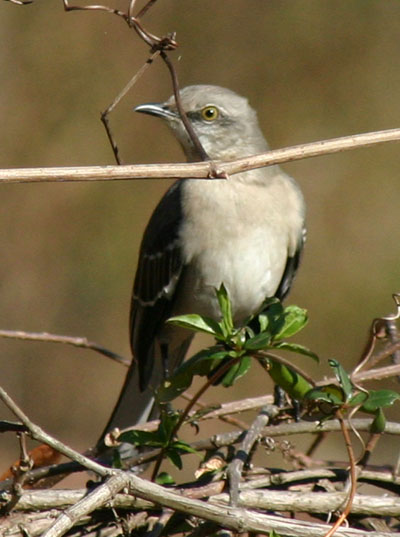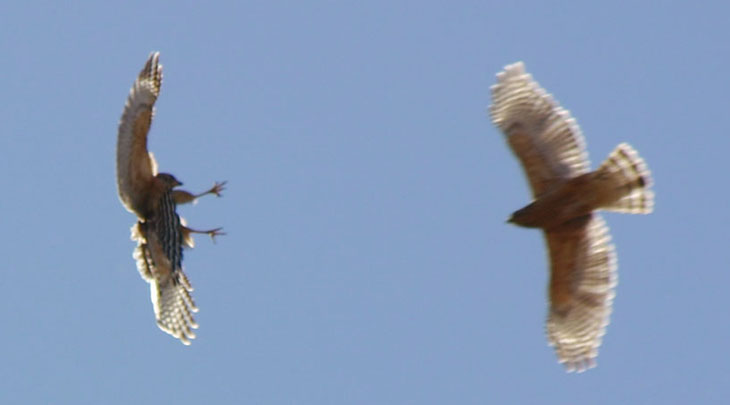
While I mentioned this before, people might still be surprised to know how often I turn the autofocus off when shooting pics. There are a couple of reasons for that. Mostly, it’s when I’m trying something like catching birds in midair, where they represent too small a target for the autofocus area within the camera to obtain enough contrast, so the focus winds the entire length of its travel and back again, throwing everything in the viewfinder so far out of focus that following a moving bird becomes impossible, and when it finally returns to a point that’s close enough to try and re-center the bird, the bird is nowhere to be seen. I can certainly miss the mark with manual focus, especially when (like my subjects above) the birds are changing altitude constantly and thus require perpetual corrections. But it still remains better than losing them entirely.
Then there’s the fact that autofocus is not always precise, and may be missing the subject I’m really after or simply not locking in tight enough. Autofocus works on contrast within the selected focus point, and requires a certain amount of light. Without enough light or adequate contrast, it can be balky or simply wrong.
The point is, know what your camera can do, and when it is unlikely to produce the results you want with automatic settings. I mentioned overriding the exposure settings and the color balance in previous posts, and to do these when your subject presents itself, you need to be familiar with just how to do it – preferably, by feel without even taking your eye away from the viewfinder. Digging out your manual simply means you’re not going to get the shot, so by all means, sit down with it ahead of time and go through it. It might seem tedious, but once you use some setting to your advantage, you’ll get the value of it immediately.
 Another good habit is to check your settings routinely. Most especially when you turn the camera on, but also periodically when shooting. It’s very easy to change a setting accidentally, or on purpose and forget that you’ve done so. The time to find out is not after you’ve uploaded a busy photo session to your computer. Check mode switch, ISO, exposure settings, color settings, contrast settings – whatever you actually mess with. And one I was reminded of today: the diopter correction on the viewfinder, if you have one. This is often a little dial or slide switch right alongside the viewfinder window, which changes the focus distance in the viewfinder for your eyesight. Manual focus is really hard when the viewfinder isn’t showing you the clearest image.
Another good habit is to check your settings routinely. Most especially when you turn the camera on, but also periodically when shooting. It’s very easy to change a setting accidentally, or on purpose and forget that you’ve done so. The time to find out is not after you’ve uploaded a busy photo session to your computer. Check mode switch, ISO, exposure settings, color settings, contrast settings – whatever you actually mess with. And one I was reminded of today: the diopter correction on the viewfinder, if you have one. This is often a little dial or slide switch right alongside the viewfinder window, which changes the focus distance in the viewfinder for your eyesight. Manual focus is really hard when the viewfinder isn’t showing you the clearest image.
Can you instantly shut off the autofocus and find the manual focus ring on your lens? If not, learn how now. When the subject is too crowded or too low in contrast for the autofocus to snag, or the light too low to produce decent results, or the teleconverter or extension tube reduces the light so that the autofocus doesn’t receive enough to work, you need to take over, and quickly, while your subject and composition are as you want them. It should be second-nature to you if you’re serious about getting the best shots that you can. It’s such a simple thing, not something to miss pics over.
And the same goes for exposure compensation. Against a bright sky, the camera will almost certainly select the wrong exposure, making things too dark because it’s programmed to expose for a midtone. And in fact, two of the cameras I’ve used have been slightly off for ideal exposure anyway, so my “neutral” setting is actually 1/3 stop overexposed anyway – with sky colors like above and below, I add an additional 2/3 to one full stop, and with overcast I often go as much as two stops over. While this blows the clouds out unnaturally white, it brightens a bird subject that is receiving too little ambient light because the clouds aren’t letting through enough to bounce from the surrounding air and surfaces.
So get that manual out, memorize those controls, close your eyes and practice. When the moment comes, it might just be that edge that you need. The pic below, while not as sharp as it could be, is also better than missing the shot entirely as these two red-shouldered hawks dueled over mating rights.





















































